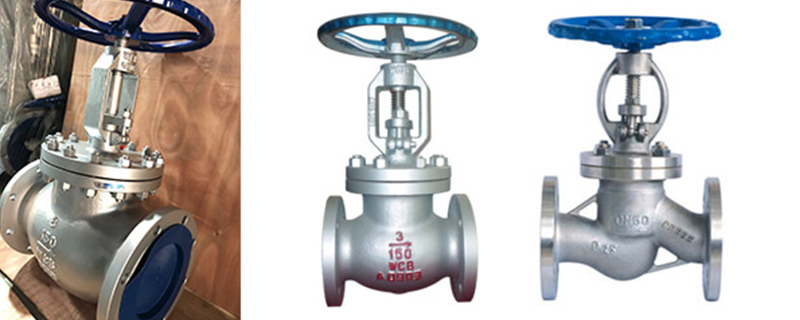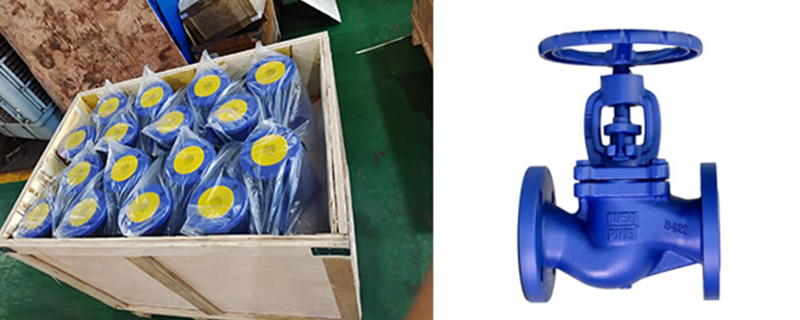Definition of globe valve:
The opening and closing member (valve new) driven by the valve stem, along the valve seat (sealing surface) axis to do linear lifting movement of the valve is called a globe valve.
Globe valve is generally driven by the drive parts (handwheel, stem, valve body, valve cover, valve flap (closure) and packing assembly, and other major components. The handwheel is connected to the valve stem, and the valve flap is driven by the valve stem, so that the valve flap moves reciprocally along the direction of the valve seat axis, thus making the pipeline connected or cut off.
The globe valve is widely used, mainly for higher pressure and smaller caliber occasions, generally only produced to DN400 (NPS 16), the larger diameter specifications only for special pipelines. For example, a large oxygen pipeline, due to the existence of other valves friction is prone to static fire, so the use of a large-diameter stainless steel globe valve.

The working principle of the globe valve:
Globe valve stem generally do rotary lifting movement, handwheel fixed in the top of the stem. When the handwheel is rotated clockwise, the stem threads rotate down, the valve sealing surface and the valve seat sealing surface in close contact, and the shut-off valve closes; when the handwheel is rotated counterclockwise, the stem threads rotate up, the valve sealing surface and the valve seat sealing surface disengage, the shut-off valve open.

The advantages and disadvantages of the globe valve:
The advantages of the globe valve:
#1 Compared with the gate valve, the globe valve structure is simpler, usually only one sealing surface on the valve body and valve flap, small sealing area, saving valuable materials, low cost, and therefore better manufacturing process, easy maintenance.
#2 The seal surface wear and abrasion are light, good sealing. No relative sliding between the valve flap and body sealing surface when opening and closing (except for the conical sealing surface), so the wear and abrasion are not serious, good sealing performance, and long service life.
#3 Opening height is small, generally only 1/4 of the diameter of the valve seat channel, compact structure, saving installation space.
#4 Precise flow control: Globe valves are particularly useful for applications that require precise control of fluid flow. They can be adjusted to provide a wide range of flow rates, making them suitable for a variety of industrial applications.
#5 High-pressure rating: Globe valves can handle high-pressure applications because of their unique design. This makes them ideal for use in piping systems where pressure is a critical factor.
#6 Good shutoff capability: Globe valves have a good shutoff capability, which is particularly useful in applications where tight shut-off is required. This helps ensure that the valve prevents the flow of fluids in both directions.
#7 Versatility: Globe valves can be used with a wide range of fluids, including gases, liquids, and slurries. This makes them useful in a variety of industries, including petrochemical, manufacturing, refining, and water treatment.
#8 Long lifespan: Globe valves are durable and can last for many years with proper maintenance, which can save money over the long term. They are also less prone to leakage, which can prevent damage to equipment or surrounding areas.
Disadvantages of globe valve:
#1 Pressure drop: Globe valves are known to create a significant pressure drop across the valve when fully open, due to their inherent design. This can reduce the efficiency of the system and require additional energy to maintain flow rates.
#2 Size and weight: Globe valves are generally larger and heavier than many other types of valves, which can make them more difficult to install and require larger support structures.
#3 Cost: Globe valves can be more expensive than some other types of valves due to their complexity and precision required for manufacturing and installation.
#4 Maintenance: Globe valves have multiple internal components that can wear or become damaged over time, requiring more frequent maintenance than simpler valve types.
#5 Limited suitability for high flow rates: Globe valves can be prone to cavitation and erosion in high-flow applications, which can limit their suitability for certain situations.
Globe valves can be classified based on different criteria. Here are some of the common classifications of globe valves:
#1. Based on design: Globe valves can be classified based on their design, such as T-pattern, Y-pattern, and angle pattern. Each design has unique characteristics, such as better flow control, reduced pressure drop, or being more suitable for high-pressure applications.
#2. Based on valve body material: Globe valves are made from different materials, including stainless steel, carbon steel, bronze, brass, and cast iron. The material used for the valve body and other components depends on the type of fluid to be handled, pressure, temperature, and durability requirements.
#3. Based on the valve stem: Globe valves can be classified based on the type of valve stem used, such as rising stem, non-rising stem, or rotary stem. The stem type determines the way the valve disk or plug is moved to regulate or shut off the flow of fluid.
#4. Based on the number of ports: Globe valves can also be classified based on the number of ports, such as single-port or double-port. Single-port globe valves have one inlet and one outlet port. Double-port, or 3-way, globe valves have three or more ports, which allow for more complex flow path configurations.
#5. Based on the operating mechanism: Globe valves can also be classified based on their operating mechanism, such as manual, electric, pneumatic, hydraulic, or solenoid-operated. The operating mechanism determines how the valve is opened or closed and is based on the application requirements.
The following application conditions are suitable for globe valves:
#1. High-pressure applications: Globe valves are suitable for high-pressure piping systems, where there is a high risk of fluid escaping.
#2. Precise flow control: Globe valves are ideal for controlling the flow rate of process fluids with high precision.
#3. High-temperature applications: Globe valves can perform well in high-temperature environments where other valve types may be prone to failure.
#4. Corrosive or abrasive fluids: Globe valves are suitable for use with corrosive or abrasive fluids due to the availability of valve components with specific material compatibility.
#5. Liquid services: Globe valves are commonly used in liquid services, such as water treatment plants or chemical processing facilities.
#6. Process control: Globe valves are effective in controlling process conditions, such as pressure, temperature, or flow rate, where accuracy is essential.
#7. High-viscosity fluids: Globe valves can handle high-viscosity fluids, such as slurries or lubricants with a higher degree of precision.
Overall, globe valves are ideal for applications requiring precise control, good shutoff capability, and adaptable flow rates. They provide accurate adjustments in the flow of fluids and are reliable in controlling pressure and temperature conditions in a piping system.